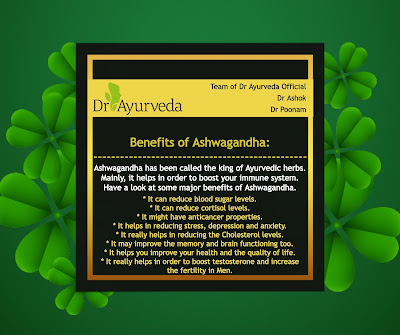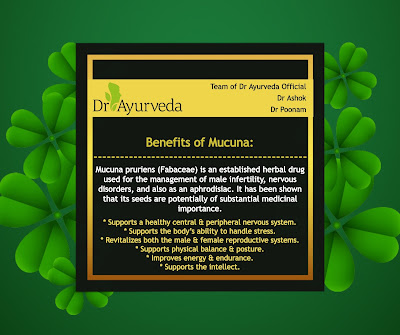Bitter melon is a great source of several key nutrients. Bitter melon is especially rich in vitamin C, an important micronutrient involved in disease prevention, bone formation, and wound healing. Stay connected for more Ayurveda Herbs related information.
Are you skeptical about herbal medicines? Don't worry. Get all information about common Ayurvedic herbs and herbal medicines, right here with Dr Ayurveda Official.
Tuesday, September 29, 2020
Monday, September 28, 2020
What is Ayurveda? Explanation by Dr Ayurveda Official
What is Ayurveda? Explanation by Dr Ayurveda Official
❖ Ayurveda is the ancient system of holistic healing and evolved in Asia over 5000 years ago
❖ It was founded by the ancient sages who produced this unique and original health care system
❖ Ayurveda applies to all living beings
❖ The word Ayurveda originates from Sanskrit (the most oldest language) and is derived from the two roots, vid = knowledge and ayus = daily living or life cycle
❖ Therefore, Ayurveda is the knowledge of daily living and the life cycle
❖ In Ayurveda, the human is considered to be a combination of the three components: physical, mental and spiritual. The balance of all three is considered to be the key of health within this health care system
❖ The principles of Ayurveda is based on the three doshas (tridoshas): vata, pitta and kapha. These are energies that are present throughout the body and mind. They regulate every physiological and psychological process in the living being. When unbalanced, they cause various signs and symptoms, leading to complex diseases and problems if left untreated
❖ Ayurveda also encompasses meditation, yoga, astrology, panchakarma (therapy for detoxification and rejuvenation) and herbo minerals
❖ It is not just confined to medicine but considers the overall lifestyle both physically and spiritually
❖ The aim of Ayurveda is to guide towards contentment optimal well being
Enable Ginger Cannot connect to Ginger Check your internet connection
or reload the browser Disable in this text field Edit Edit in Ginger Edit in Ginger ×
Enable Ginger Cannot connect to Ginger Check your internet connection
or reload the browser Disable in this text field Edit Edit in Ginger Edit in Ginger × Enable Ginger Cannot connect to Ginger Check your internet connection
or reload the browser Disable in this text field Edit Edit in Ginger Edit in Ginger ×
❖ Ayurveda is the ancient system of holistic healing and evolved in Asia over 5000 years ago
❖ It was founded by the ancient sages who produced this unique and original health care system
❖ Ayurveda applies to all living beings
❖ The word Ayurveda originates from Sanskrit (the most oldest language) and is derived from the two roots, vid = knowledge and ayus = daily living or life cycle
❖ Therefore, Ayurveda is the knowledge of daily living and the life cycle
❖ In Ayurveda, the human is considered to be a combination of the three components: physical, mental and spiritual. The balance of all three is considered to be the key of health within this health care system
❖ The principles of Ayurveda is based on the three doshas (tridoshas): vata, pitta and kapha. These are energies that are present throughout the body and mind. They regulate every physiological and psychological process in the living being. When unbalanced, they cause various signs and symptoms, leading to complex diseases and problems if left untreated
❖ Ayurveda also encompasses meditation, yoga, astrology, panchakarma (therapy for detoxification and rejuvenation) and herbo minerals
❖ It is not just confined to medicine but considers the overall lifestyle both physically and spiritually
❖ The aim of Ayurveda is to guide towards contentment optimal well being
or reload the browser
or reload the browser
or reload the browser
Saturday, September 26, 2020
Avalambaka Kapha in Ayurveda by Dr Ayurveda Official
Avalambaka Kapha in Ayurveda by Dr Ayurveda Official:
There are 5 types of Kapha:
* Tarpaka Kapha
* Bodhaka Kapha
* Sleshaka Kapha
* Avalambaka Kapha
* Kledaka Kapha
Let's get to know about Avalambaka Kapha in details:
Location:
The seat of Alochakapitta is in the in Drishti - eyes.
Functions:
The function of the Alochakapitta is to catch the image, form and color of any external object presented to the eye. It is present in the frontal area of the brain, responsible with the process of memory, mainly associated with the experience through vision.Enable Ginger Cannot connect to Ginger Check your internet connection
or reload the browser Disable in this text field Edit Edit in Ginger Edit in Ginger × Enable Ginger Cannot connect to Ginger Check your internet connection
or reload the browser Disable in this text field Edit Edit in Ginger Edit in Ginger ×
There are 5 types of Kapha:
* Tarpaka Kapha
* Bodhaka Kapha
* Sleshaka Kapha
* Avalambaka Kapha
* Kledaka Kapha
Let's get to know about Avalambaka Kapha in details:
Location:
The seat of Alochakapitta is in the in Drishti - eyes.
Functions:
The function of the Alochakapitta is to catch the image, form and color of any external object presented to the eye. It is present in the frontal area of the brain, responsible with the process of memory, mainly associated with the experience through vision.
or reload the browser
or reload the browser
Friday, September 25, 2020
Ashwagandha benefits by Dr Ayurveda Official
Let's talk about the "King of Ayurvedic Herbs: Ashwagandha". It has so many health benefits, that you must know about.
Supplementing with ashwagandha may be an easy and effective way to improve your health and quality of life.
Stay connected for more Ayurveda Herbs related information by "Dr Ayurveda Official."
or reload the browser
Wednesday, September 23, 2020
Sleshaka Kapha in Ayurveda by Dr Ayurveda Official:
Sleshaka Kapha in Ayurveda by Dr Ayurveda Official:
There are 5 types of Kapha:
* Tarpaka Kapha
* Bodhaka Kapha
* Sleshaka Kapha
* Avalambaka Kapha
* Kledaka Kapha
Let's get to know about Sleshaka Kapha in details:
There are 5 types of Kapha:
* Tarpaka Kapha
* Bodhaka Kapha
* Sleshaka Kapha
* Avalambaka Kapha
* Kledaka Kapha
Let's get to know about Sleshaka Kapha in details:
Location:
Sleshaka is located in the joints of the body and refers to the synovial fluid in the joints.
Functions:
It keeps the joints firmly united by keeping the membranes and joints smooth, lubricated and nourished. This makes the joints flexible and strong.Enable Ginger Cannot connect to Ginger Check your internet connection
or reload the browser Disable in this text field Edit Edit in Ginger Edit in Ginger ×
Sleshaka is located in the joints of the body and refers to the synovial fluid in the joints.
Functions:
It keeps the joints firmly united by keeping the membranes and joints smooth, lubricated and nourished. This makes the joints flexible and strong.
or reload the browser
Monday, September 21, 2020
Mucuna herb benefits by Dr Ayurveda Official
Have a look at Mucuna herb benefits by Dr Ayurveda Official. Stay connected for more Ayurveda Herbs related information.
or reload the browser
or reload the browser
Saturday, September 19, 2020
Bodhaka Kapha in Ayurveda by Dr Ayurveda Official
Bodhaka Kapha in Ayurveda by Dr Ayurveda Official:Enable Ginger Cannot connect to Ginger Check your internet connection
or reload the browser Disable in this text field Edit Edit in Ginger Edit in Ginger ×
There are 5 types of Kapha:
* Tarpaka Kapha
* Bodhaka Kapha
* Sleshaka Kapha
* Avalambaka Kapha
* Kledaka Kapha
Let's get to know about Bodhaka Kapha in details:
Bodhan means – to make aware.* Tarpaka Kapha
* Bodhaka Kapha
* Sleshaka Kapha
* Avalambaka Kapha
* Kledaka Kapha
Let's get to know about Bodhaka Kapha in details:
Location:
Bhodhaka is located in the root of the tongue and the throat.
Functions:
It enables taste perception. In the form of saliva, it differentiates the six tastes and makes the tongue perceive them. It lubricates the oral cavity and initiates the digestion process.
Bhodhaka is located in the root of the tongue and the throat.
Functions:
It enables taste perception. In the form of saliva, it differentiates the six tastes and makes the tongue perceive them. It lubricates the oral cavity and initiates the digestion process.
or reload the browser
Subscribe to:
Comments (Atom)






